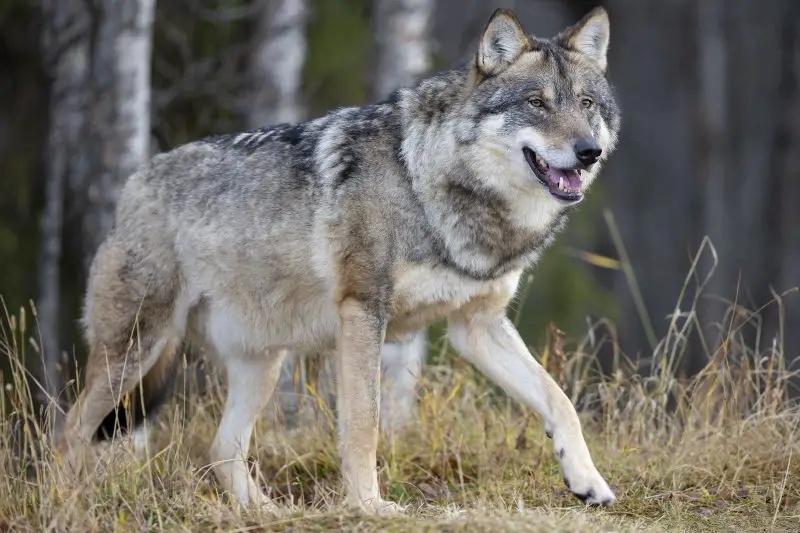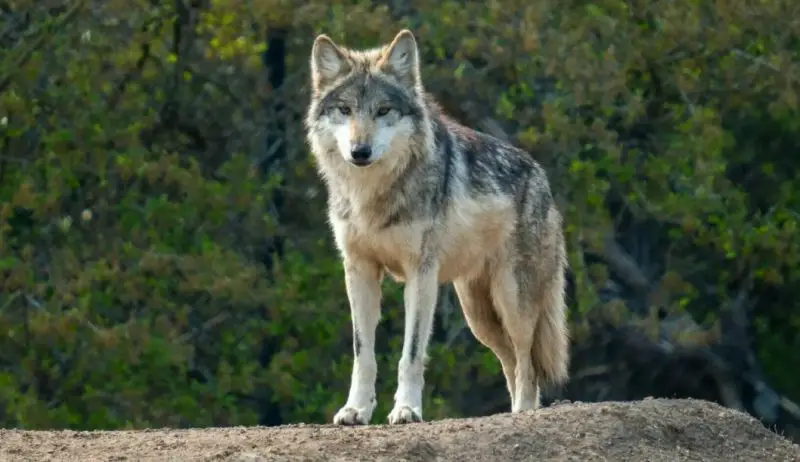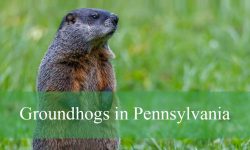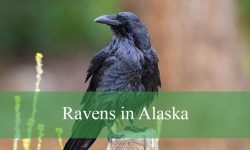Wolves have long been symbols of wilderness in North America, and Colorado holds a particularly fascinating story about their past, present, and future. Once widespread across the Rocky Mountains and Great Plains, wolves disappeared from Colorado by the mid-20th century due to hunting and habitat loss. Today, however, efforts are underway to bring them back, and the state is once again becoming home to these iconic predators.
Scientifically, only one species of wolf lives in Colorado: the gray wolf (Canis lupus). Yet within this species, there are several subspecies that matter for understanding history and conservation. When people talk about wolf types in Colorado, they are usually referring to three forms of gray wolf: the general gray wolf, the northwestern wolf, and the Mexican wolf. Each of these subspecies has unique traits in appearance, behavior, and ecological roles.
This article explores the three types of wolves in Colorado, explains how they are identified, and dives into their habitat, reproduction, hunting strategies, and even some fun facts. By the end, you will see how these wolves shape Colorado’s wild landscapes and why their return is so significant.
Gray Wolf in Colorado

Characteristics and Identification
The gray wolf is the primary species tied to Colorado. Known scientifically as Canis lupus, this animal is one of the most adaptable predators in the world. Adult gray wolves typically weigh between 70 and 110 pounds, though size varies with geography. Their coats come in a mix of gray, brown, black, and white, with some individuals appearing almost solid black or completely pale. Gray wolves are highly social, forming packs with complex hierarchies where alpha pairs lead the group.
In Colorado, gray wolves are identified by their tall stature, broad heads, and long legs. They can easily be distinguished from coyotes by their larger size and fuller, bushier tails. While coyotes rarely exceed 40 pounds, a wolf’s sheer size makes it unmistakable. Their howls are also deeper and carry farther across the mountains and valleys, serving both as communication within packs and as territorial signals.
Habitat and Range
Historically, gray wolves roamed nearly every corner of Colorado, from the high mountain meadows to the prairies and foothills. They were extirpated from the state by the 1940s, primarily due to predator eradication campaigns. In recent years, wolves have naturally dispersed into northern Colorado from Wyoming, and in 2020, voters approved a ballot initiative to actively reintroduce them.
Wolves thrive in ecosystems where prey is abundant. In Colorado, elk and mule deer are the main targets, but they will also feed on smaller mammals, carrion, and even livestock when opportunities arise. Their presence plays a vital ecological role by balancing herbivore populations and indirectly shaping vegetation growth in riparian areas.
Behavior and Reproduction
Gray wolves are highly intelligent and cooperative hunters. Packs usually consist of 6 to 10 members, though numbers may fluctuate depending on food supply. Their social structure is built around cooperation, with all members helping to raise the young. Pups are born in spring after a 63-day gestation, usually in dens dug into hillsides or under tree roots. A typical litter contains four to six pups, which are cared for by both parents and older siblings.
Hunting in Colorado involves tracking large ungulates across rugged terrain. Wolves rely on endurance rather than speed, often testing herds to find weak or injured individuals. Successful hunts provide enough food to sustain the entire pack, and they are known to cache extra meat for later.
Fun Fact about the Gray Wolf
One fascinating fact about gray wolves is that their howls can be heard from up to 10 miles away in open terrain. Each wolf’s howl is unique, much like a human voice, allowing pack members to recognize one another across vast distances. In Colorado’s wilderness, hearing a wolf’s howl is both a scientific marker of recovery and a deeply moving reminder of wildness returning to the land.
Northwestern Wolf in Colorado

Characteristics and Identification
The northwestern wolf (Canis lupus occidentalis) is a subspecies of gray wolf that plays a central role in wolf recovery programs across the northern Rockies. It is one of the largest wolf types in North America, with males often weighing between 100 and 130 pounds. Their bodies are stocky and muscular, adapted for taking down large prey such as elk, moose, and bison. Coat colors range from grizzled gray to black, with thick fur suited for cold climates.
Identification of this wolf in Colorado is primarily tied to reintroduction efforts. Many of the wolves released in Yellowstone National Park during the 1990s came from northwestern wolf populations in Canada, and dispersing individuals have since moved into surrounding states. The wolves being reintroduced into Colorado are likely to come from the same genetic stock, meaning this subspecies will shape Colorado’s wolf future.
Habitat and Range
Northwestern wolves thrive in rugged landscapes with dense forests, alpine meadows, and river valleys. In Colorado, they are expected to establish territories in the northern and central mountains, particularly areas with abundant elk populations. The San Juan Mountains and the Western Slope provide excellent habitat conditions, combining prey availability with sufficient cover for denning and hunting.
These wolves prefer large, relatively undisturbed territories. A single pack can occupy a range of several hundred square miles, patrolling and defending it from rival groups. Their movement patterns often follow seasonal migrations of elk and deer, meaning they may be seen in different elevations at different times of year.
Behavior and Reproduction
Northwestern wolves live in cooperative family groups, with breeding pairs producing litters each spring. Given their large size, they are capable of tackling big prey, which requires coordinated pack strategies. A hunt may involve wolves chasing an elk herd into steep terrain, separating individuals, and wearing them down over long distances. This hunting method plays an essential role in maintaining healthy prey populations by removing the weakest animals.
Reproduction patterns are similar to other gray wolves, but litters can be slightly larger, averaging five to seven pups. Packs devote significant energy to raising young, with older siblings regurgitating food and helping guard dens. By late summer, pups begin following adults on hunts, learning the skills necessary for survival.
Fun Fact about the Northwestern Wolf
Northwestern wolves are known for their endurance in harsh climates. They can travel more than 20 miles in a single day while patrolling or hunting. In some documented cases, individuals have dispersed more than 500 miles from their natal packs. This extraordinary mobility explains how wolves from the northern Rockies have naturally made their way into Colorado even before reintroduction programs began.
Mexican Wolf in Colorado

Characteristics and Identification
The Mexican wolf (Canis lupus baileyi) represents the smallest and southernmost subspecies of gray wolf in North America. Adults usually weigh between 50 and 80 pounds, making them slimmer and lighter than their northern relatives. Their coats are distinct, with a mixture of gray, brown, black, and cream, giving them a mottled appearance that blends well with arid landscapes. Long legs and lean frames make them highly agile.
Identification in Colorado is mainly historical. Mexican wolves once roamed southern parts of the state, particularly along the border with New Mexico. They were extirpated by the early 20th century but have since been reintroduced into Arizona and New Mexico. While they are not currently part of Colorado’s active reintroduction program, their historical presence means they remain part of Colorado’s wolf heritage.
Habitat and Range
Mexican wolves prefer semi-arid forests, grasslands, and scrublands. Unlike the northwestern wolf, which thrives in colder alpine habitats, Mexican wolves are adapted to warmer environments. Their range historically included southern Colorado, New Mexico, Arizona, and northern Mexico. Today, reintroduced populations are primarily found in the Blue Range Wolf Recovery Area along the Arizona–New Mexico border.
If conservation discussions ever expand to include them in Colorado, Mexican wolves would likely inhabit the southern mountains and plateaus, where ecosystems mirror their native habitats. However, current recovery plans focus more on New Mexico and Arizona, leaving the question of their role in Colorado’s future still open.
Behavior and Reproduction
Mexican wolves share many social traits with other gray wolves but tend to live in smaller packs, usually four to six individuals. Their smaller body size means they focus on hunting medium-sized prey such as deer, javelina, and smaller mammals. Nevertheless, they are capable of taking elk when conditions favor them.
Breeding occurs once a year, with litters averaging four to six pups. Because populations are still recovering from near extinction, captive breeding programs play a crucial role in maintaining genetic diversity. Pups born in captivity are sometimes placed into wild dens to increase survival rates and strengthen wild packs.
Fun Fact about the Mexican Wolf
Mexican wolves are sometimes called “lobos,” a name that comes from the Spanish word for wolf. This cultural connection highlights the deep historical ties between wolves and people in the American Southwest. Today, “lobo” is both a conservation symbol and a reminder of the region’s unique ecological heritage.
Comparison of the 3 Types of Wolves in Colorado
Feature |
Gray Wolf (Canis lupus) |
Northwestern Wolf (Canis lupus occidentalis) |
Mexican Wolf (Canis lupus baileyi) |
|---|---|---|---|
Average Size |
70–110 pounds, 4.5–6 ft long |
100–130+ pounds, up to 6.5 ft long |
50–80 pounds, 4–5 ft long |
Coat Color |
Gray, black, white, or brown mix |
Mostly gray to black, thick fur for cold climates |
Gray-brown mix with black streaks |
Habitat Preference |
Forests, mountains, meadows |
Alpine forests, valleys, rugged wilderness |
Semi-arid forests, grasslands, scrub |
Pack Size |
6–10 wolves |
6–12 wolves, sometimes larger |
4–6 wolves, smaller groups |
Main Prey |
Elk, mule deer, small mammals |
Elk, moose, bison, large ungulates |
Deer, javelina, smaller mammals |
Current Status in CO |
Present through reintroduction |
Main subspecies in reintroduction efforts |
Historically present, not reintroduced |
Unique Trait |
Highly adaptable, wide range |
Largest body size of all gray wolf subspecies |
Smallest North American wolf |
Best Times and Locations to Observe Wolves in Colorado
Best Time of Day
The best times to observe wolves in Colorado are during the early mornings and late evenings. Wolves are generally crepuscular, meaning they are most active at dawn and dusk. These are the hours when packs set out to hunt or return to their dens, making movement across meadows, valleys, and ridgelines more visible. In winter months, wolves may also remain active throughout the day, especially after fresh snowfall, when hunting conditions are favorable.
During spring and early summer, observing wolves may be more challenging because packs spend more time near their dens raising pups. However, you may still catch sight of them in the early morning as adults move in and out of denning areas to provide food. Autumn is another excellent period, as elk and deer migrations attract wolves to open landscapes where their activity becomes easier to track.
Best Locations in Colorado
Wolves in Colorado are currently concentrated in the northwestern part of the state, where reintroduction efforts are focused. Areas such as Routt County, Moffat County, and Grand County provide expansive wilderness with rich elk populations, offering ideal conditions for wolves to thrive. The Flat Tops Wilderness, White River National Forest, and surrounding mountain ranges are among the top regions where wolf sightings are most likely.
As populations expand, wolves are expected to disperse into central and southern Colorado, particularly the San Juan Mountains and the Western Slope. These areas provide abundant prey and rugged terrain, creating long-term potential habitats. Observing wolves in these regions requires patience, as they cover large territories and can travel 20 miles or more in a single day.
Responsible Observation
Anyone hoping to observe wolves in Colorado should practice responsible wildlife watching. Wolves are cautious of humans and should never be approached or fed. Using binoculars or spotting scopes from a distance is the safest and most ethical way to enjoy watching them. Winter tracking after fresh snow can reveal footprints and trails, giving valuable clues about pack movement without direct disturbance.
Wildlife watchers should also remember that wolves are still reestablishing themselves in Colorado, meaning sightings may remain rare in the early years of recovery. Hearing a distant howl, spotting fresh tracks, or glimpsing a moving silhouette across a ridge can be just as rewarding as a full visual encounter. The key is patience, respect, and an appreciation for the role these animals play in Colorado’s wild landscapes.
Why Subspecies Matter in Colorado
While there is technically only one species of wolf in Colorado—the gray wolf—the recognition of subspecies is important for conservation. The northwestern wolf represents the genetic stock most likely to repopulate Colorado through both reintroduction and natural migration. The Mexican wolf, although not currently in Colorado, represents a piece of the state’s historical biodiversity and cultural history.
Understanding these distinctions helps wildlife managers make informed decisions about recovery strategies. For example, introducing northwestern wolves ensures stronger population growth, while protecting Mexican wolves preserves genetic diversity. Both play different but important roles in the broader story of wolf recovery in the American West.
Conclusion
The three types of wolves in Colorado—gray wolves in general, northwestern wolves, and Mexican wolves—tell a story of loss, resilience, and renewal. Each type has unique traits that influence how they hunt, reproduce, and interact with their environments. Gray wolves are returning to Colorado thanks to natural dispersal and reintroduction programs, with northwestern wolves likely becoming the dominant subspecies. Meanwhile, the Mexican wolf remains a symbol of southern Colorado’s historical wildness.
As these wolves reclaim their place in Colorado’s mountains and forests, they bring balance to ecosystems and inspiration to people who value the wild. The sight of a wolf pack moving across a snowy meadow or the sound of a howl echoing through a canyon is more than just a natural encounter—it is a testament to Colorado’s commitment to restoring its ecological heritage.
FAQs about Wolves in Colorado
Are there wild wolves in Colorado?
Yes, wild wolves are once again present in Colorado. After being absent for nearly 80 years, wolves naturally dispersed from Wyoming into northern Colorado in the 2000s. In 2020, voters approved a statewide initiative to reintroduce gray wolves, and active releases began in 2023. While populations remain small, sightings and confirmed tracks are increasing, especially in the northwestern part of the state.
What do wolves eat in Colorado?
Wolves in Colorado primarily hunt elk and mule deer, which are abundant in the Rocky Mountains and Western Slope. They also feed on smaller animals such as rabbits, beavers, and ground-dwelling rodents. When natural prey is scarce, wolves may scavenge carrion or occasionally prey on livestock, which has created challenges for ranchers. Overall, their diet plays a crucial role in keeping herbivore populations balanced.
How big are wolves in Colorado?
Adult wolves in Colorado generally weigh between 70 and 110 pounds, with males being larger than females. Northwestern wolves, which are part of the reintroduction program, can grow even bigger, sometimes exceeding 120 pounds. Their body length typically ranges from 4.5 to 6 feet, including the tail, and their shoulder height averages 26 to 32 inches.
Where is the best place to see wolves in Colorado?
The best chance to see wolves in Colorado is in the northwestern region of the state, particularly in areas like Routt County, Moffat County, and Grand County. Wilderness regions such as the Flat Tops Wilderness and White River National Forest are promising locations. Wolves are elusive and cover large territories, so sightings require patience, but their presence is slowly expanding into central and southern mountains.
Do wolves in Colorado pose a danger to humans?
Wolves are generally not dangerous to humans. Attacks on people are extremely rare in North America, and wolves typically avoid human contact. They are shy, intelligent animals that prefer to hunt natural prey rather than interact with people. The main conflicts arise with livestock predation, which is why Colorado has implemented compensation programs for ranchers who lose animals to wolves.
Are Mexican wolves found in Colorado?
Historically, Mexican wolves lived in southern Colorado, but they were extirpated by the early 20th century. Today, wild Mexican wolf populations exist in Arizona, New Mexico, and Mexico, but not currently in Colorado. Conservation discussions sometimes mention their potential return to southern Colorado, though active reintroduction efforts in the state focus on northwestern wolves.
What role do wolves play in Colorado’s ecosystem?
Wolves are keystone predators that help regulate herbivore populations, particularly elk and deer. By preying on the weak, sick, or old individuals, wolves keep prey herds healthy and prevent overgrazing of vegetation. Their presence also indirectly benefits riparian habitats, songbirds, and beavers by allowing vegetation to regenerate. In Colorado, wolf restoration is expected to bring similar ecological balance as seen in Yellowstone National Park.






